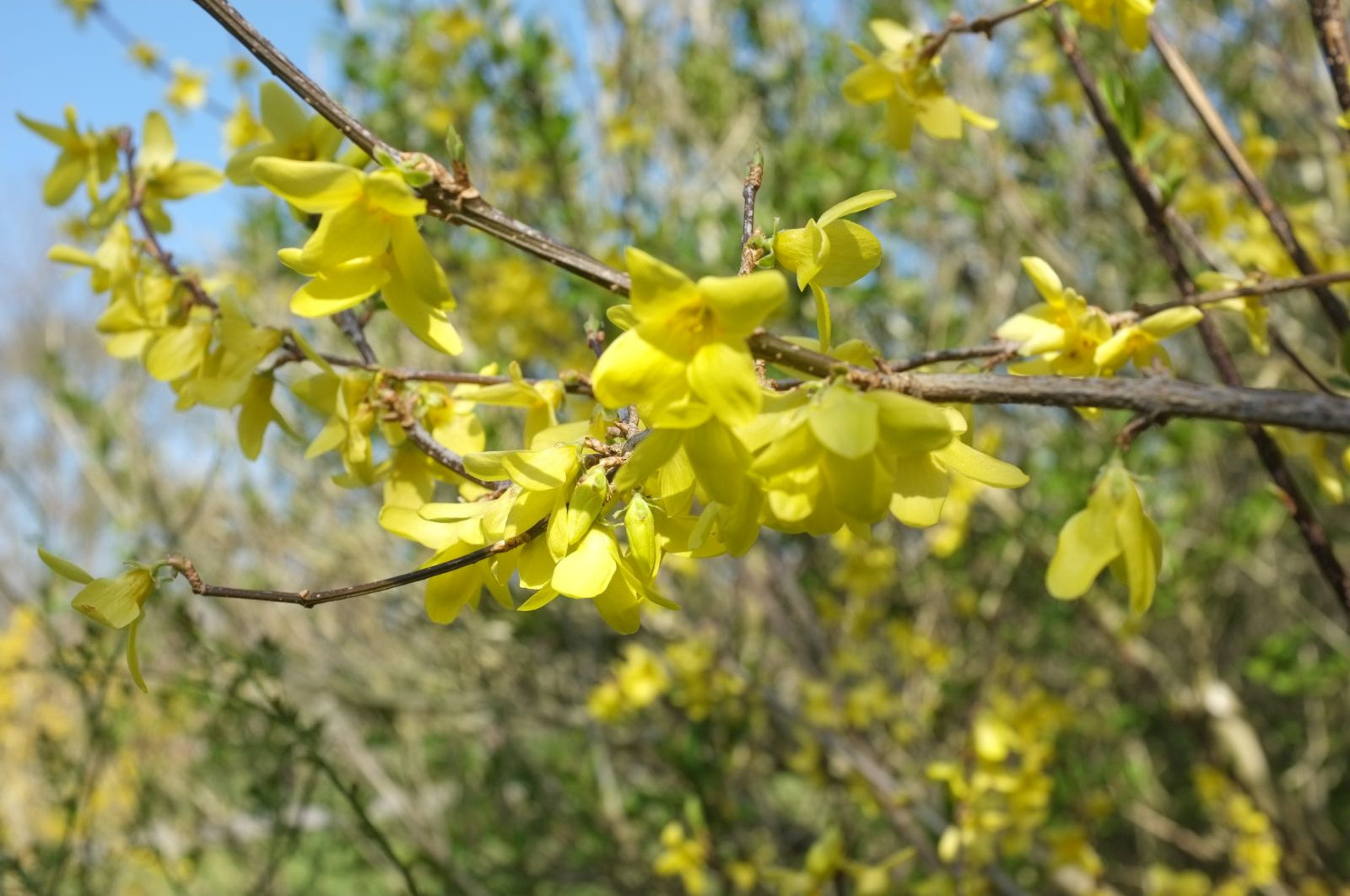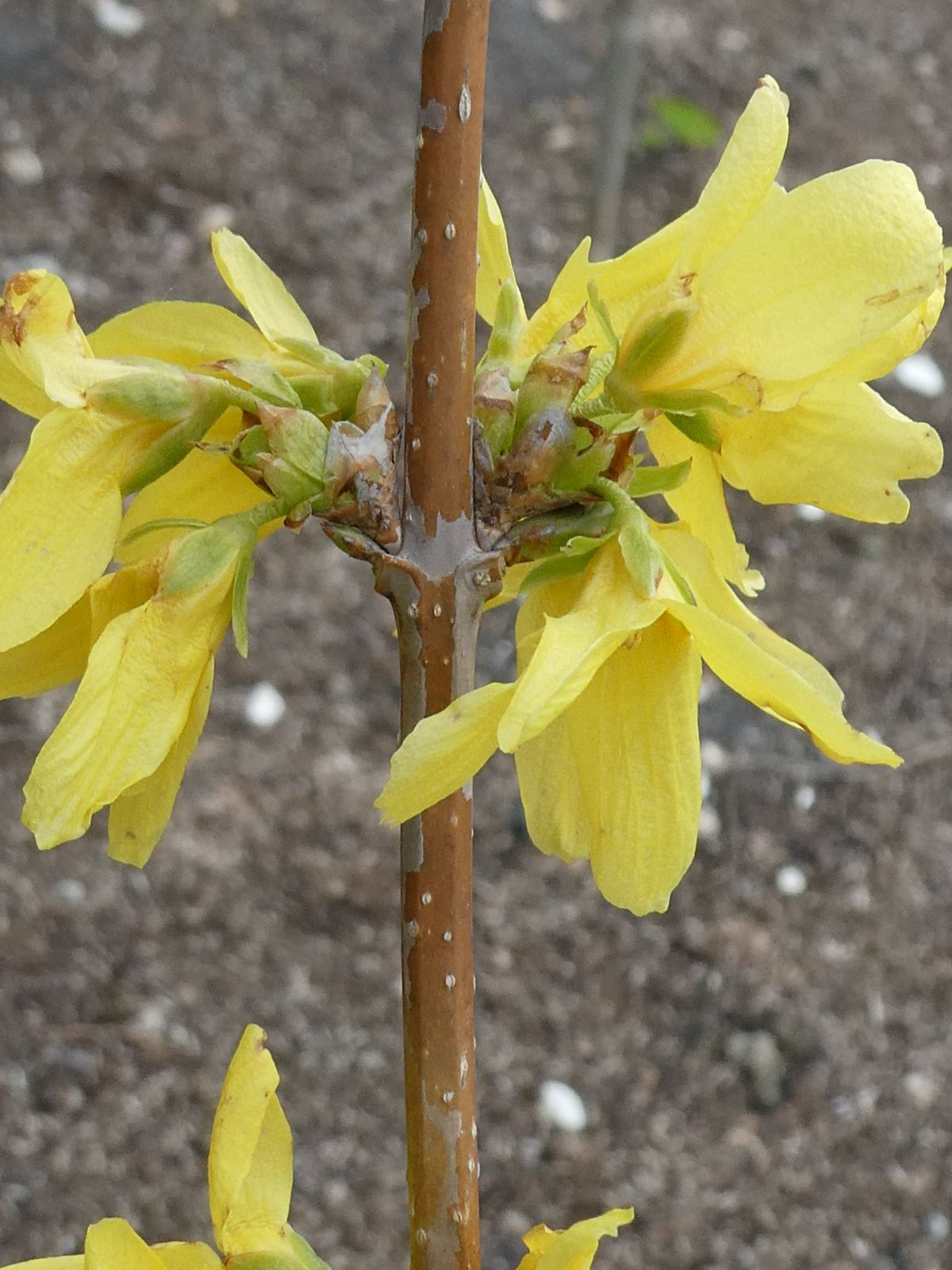Forsythia suspensa
Sponsor
Kindly sponsored by
Monique Gudgeon, Sculpture by the Lakes
Credits
Owen Johnson (2022)
Recommended citation
Johnson, O. (2022), 'Forsythia suspensa' from the website Trees and Shrubs Online (treesandshrubsonline.
Genus
Common Names
- Weeping Forsythia
Synonyms
- Ligustrum suspensum Thunb.
- Forsythia fortunei Lindl.
- Forsythia suspensa var. fortunei (Lindl.) Rehd.
- Forsythia suspensa var. latifolia Rehd.
- Forsythia suspensa var. sieboldii Zab.
- Rangium suspensum (Thunb.) Ohwi
- Syringa suspensa (Thunb.) Thunb. ex Murray
- Syringa suspensa f. atrocaulis Redh.
Infraspecifics
Other taxa in genus
- Forsythia 'Arnold Dwarf'
- Forsythia europaea
- Forsythia 'Fontanna'
- Forsythia 'Ford Freeway'
- Forsythia giraldiana
- Forsythia 'Gold Splash'
- Forsythia 'Golden Times'
- Forsythia 'Happy Centennial'
- Forsythia 'Helios'
- Forsythia × intermedia
- Forsythia japonica
- Forsythia 'Kanárek'
- Forsythia × kobendzae
- Forsythia koreana
- Forsythia likiangensis
- Forsythia 'Little Renee'
- Forsythia 'Maluch'
- Forsythia × mandshurica
- Forsythia 'Meadowlark'
- Forsythia nakaii
- Forsythia 'New Hampshire Gold'
- Forsythia 'Northern Gold'
- Forsythia 'Northern Sun'
- Forsythia ovata
- Forsythia 'Paulina'
- Forsythia 'Princeton Gold'
- Forsythia 'Robusta'
- Forsythia saxatilis
- Forsythia 'Spring Beauty'
- Forsythia 'Spring Gold'
- Forsythia 'Tremonia'
- Forsythia × variabilis
- Forsythia 'Verfors'
- Forsythia viridissima
- Forsythia 'Winterthur'
- Forsythia 'Yatgold'
Shrub to 3 m tall (or much taller when scrambling up rocks or walls), with spreading or weeping branches. Twigs yellow- to grey-brown, glabrous, hollow except at the nodes. Leaves simple, or trifoliate on strong shoots; simple leaves 5–10 × 2–5 cm, broadly lanceolate to deeply 2 or 3-lobed, acuminate, rounded to cuneate at the base; margin serrate; glabrous, or pubescent especially under the veins; petiole c. 12 mm long. Flowers solitary at each leaf-scar or in clusters of 2–6. Calyx lobes oblong, ciliate, about as long as the tube. Corolla yellow, c. 3 cm wide. Fruit capsue ovoid to long-ellipsoid, 12–25 mm long. (Chang, Qiu & Green 1996; Bean 1981).
Distribution China Anhui, Hebei, Henan, Hubei, Shaanxi, Shandong, Shanxi, Sichuan
Habitat Thickets or grassy area on slopes, rocky gullies, 300–2200 m asl.
USDA Hardiness Zone 5
RHS Hardiness Rating H6
Conservation status Not evaluated (NE)
Forsythia suspensa is the most widespread species in the wild and has long been cultivated in China and Japan, both for its ornamental qualities and for its uses in traditional herbal medicine; its unripe fruit pods, called lian qiao, are ground and used to treat chills, fevers, headaches, burns and infections, but may be carcinogenic (Eat the Weeds 2013). This was also the first species to reach the west, being described in 1784 (as a species of Syringa) by Carl Pehr Thunberg, who had encountered the plant in Japan in 1775–6. It was listed in an 1817 catalogue of the Leipzig garden of Christian August Breiter, and living plants were brought to Holland by Verkerk Pistorius in 1833 (DeWolf & Hebb 1971); it was being sold by Veitch in the UK by the middle of that century (Bean 1981).
These earlier introductions probably all belonged to clones which appear to have been selected in Japanese gardens for their weeping habit, and which were once distinguished by western botanists as var. sieboldii; these plants seldom carry trifoliate leaves and the European population, in the 1890s at least, consisted of ‘thrum-eyed’ clones. The flower-stalk in this form is also unusually long for the genus (Bean 1910). A form nearer to the wild Chinese species, with many trifoliate leaves and a more upright habit, was introduced by Robert Fortune from near Beijing to Standish’s nursery in Manchester in 1862 (Bean 1981), and was at first considered a separate species (Forsythia fortunei). A truly wild collection, made by Ernest Wilson from western Hubei in 1908 (W 637) was originally described by Alfred Rehder at the Arnold Arboretum as another distinct form, f. atrocaulis, with purplish young stems and unfolding leaves and rich brown older shoots, but is now also considered to be another part of this species’ natural variation.
Forsythia suspensa can be considered in several ways as the joker in an otherwise rather uniform pack of species. The hollow pith is unique, while the trifoliate leaves and the weeping habit might suggest a spring version of Winter Jasmine Jasminum nudiflorum – though these two distinctive traits are seldom combined in the same plant. The large flowers, carried in clusters of up to six at each leaf-scar – or up to twelve at each node – are also distinctive, and contribute to the supreme floral display of the garden hybrid with F. viridissima, F. × intermedia. This hybrid was first bred by Thomas Meehan in Philadelphia in the 1860s (Bean 1981) and achieved commercial success in the early years of the 20th century, but F. suspensa is sufficiently distinctive and attractive to have remained continuously available, as a less than common garden plant.
'Aurea'
‘Aurea’, represented in the new UK National Collection of Forsythias at Sculpture by the Lakes in Dorset by cuttings taken from a plant of this name at the former collection at Pershore College.
- ‘Fortunei Aurea’ Plants sold as ‘Fortunei Aurea’ in the 1940s seemed to be typical F. suspensa (Wyman 1961), whilst a gold-variegated form available under this name in America in the 1950s was probably ‘Variegata’ (DeWolf & Hebb 1971) (q.v.).
'Decipiens'
A clone sold by Späth of Berlin from 1905, which carried its flowers singly at each leaf-scar (Wyman 1961).
'Elanor'
Advertised in 2022 by several eastern European nurseries as an apparently extra hardy strain.
'Hewitt's Gold'
A sport with yellow-green young leaves which mature to gold (Hatch 2021–2022), sold in the UK in 2022 by Monksilver Nursery. The name commemorates the English plantswoman Jennifer Hewitt, but is sometimes mis-spelled ‘Hewit’s Gold’. This clone is ‘thrum-eyed’.
'Nymans'
Synonyms / alternative names
A selection from W 637, made before 1951, with purplish young leaves and very dark, erect stems. The soft yellow ‘thrum-eyed’ flowers are very large (c. 45 mm wide), with broad, plane lobes. This is one of the last forsythias to flower (Bean 1981).
'Pallida'
A pale-flowered selection (Wyman 1961), sold by Späth of Berlin from around 1905 (Bean 1981).
'Variegata'
Synonyms / alternative names
Forsythia suspensa 'Aureo-variegata'
Forsythia suspensa 'Taff's Arnold'
The name ‘Variegata’ is first catalogued, as a sport with yellow-variegated leaves, in the Annual Report of the Pennsylvania State Agricultural College, 1899–1900. ‘Aureo-variegata’ was listed by Bernhart Koehne (Gartenflora 55, p. 206) in Germany in 1906, clearly for a very similar sport if not for the same clone. Another similar plant was later selected by the English horticulturalist Stephen Taffler, who had a special love of variegated plants, and renamed ‘Taff’s Arnold’. This is the name recommended by RHS nomenclature (RHS 2020), but may not represent the whole variety of plants in cultivation. The German form was considered an ugly plant by Gerd Krüssman and did not flower profusely (Hatch 2021–2022), but ‘Taff’s Arnold’ at least remains commercially available in the UK and can show good autumn colour.









